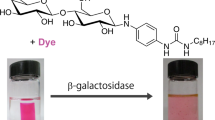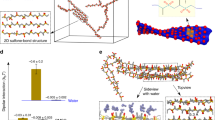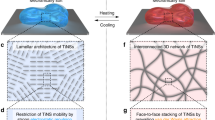Abstract
This paper describes the stimuli-responsive hydrogels constructed from bola-type amphiphiles composed of two dipeptides containing phenylalanine attached to the ends of a hydrophobic tetrathiophene. The hydrogel formation ability of the amphiphiles was affected by the N-terminal amino acid residue, which is an amphiphile-possessing phenylalanine-lysine sequence that formed a hydrogel under limited pH conditions. Gel formation occurred because of the phase transition of the gelator assembly from a granular aggregate to a fibrous architecture, in a process controlled by pH. This stimuli-responsive sol–gel transition was also accomplished by the addition of an anionic polymer, and sulfated glycosaminoglycans were successfully discriminated using the hydrogel system.
This is a preview of subscription content, access via your institution
Access options
Subscribe to this journal
Receive 12 print issues and online access
$259.00 per year
only $21.58 per issue
Buy this article
- Purchase on Springer Link
- Instant access to full article PDF
Prices may be subject to local taxes which are calculated during checkout








Similar content being viewed by others
References
Aida T, Meijer EW, Stupp SI. Functional supramolecular polymers. Science. 2012;335:813–7.
Tovar JD. Supramolecular construction of optoelectronic biomaterials. Chem Res. 2013;46:1527–37.
Shigemitsu H, Hamachi I. Design strategies of stimuli-responsive supramolecular hydrogels relying on structural analyses and cell-mimicking approaches. Acc Chem Res. 2017;50:740–50.
Li J, Mooney DJ. Designing hydrogels for controlled drug delivery. Nat Rev Mater. 2016;1:16071.
Bhattarai N, Gunn J, Zhang M. Chitosan-based hydrogels for controlled, localized drug delivery. Adv Drug Deliv Rev. 2010;62:83–99.
Zhang S. Fabrication of novel biomaterials through molecular self-assembly. Nat Biotechnol. 2003;21:1171–8.
Zhou J, Li J, Du X, Xu B. Supramolecular biofunctional materials. Biomaterials. 2017;129:1–27.
Makama P, Gazit E. Minimalistic peptide supramolecular co-assembly: expanding the conformational space for nanotechnology. Chem Soc Rev. 2018;47:3406–20.
Fleming S, Ulijn RV. Design of nanostructures based on aromatic peptide amphiphiles. Chem Soc Rev. 2014;43:8150–77.
Ma M, Kuang Y, Gao Y, Zhang Y, Gao P, Xu B. Aromatic-aromatic interactions induce the self-assembly of pentapeptidic derivatives in water to form nanofibers and supramolecular hydrogels. J Am Chem Soc. 2010;132:2719–28.
Zhang Y, Gu H, Yang Z, Xu B. Supramolecular hydrogels respond to ligand-receptor interaction. J Am Chem Soc. 2003;125:13680–1.
Berdugo C, Nalluri SKM, Javid N, Escuder B, Miravet JF, Ulijn RV. Dynamic peptide library for the discovery of charge transfer hydrogels. ACS Appl Mater Interfaces. 2015;7:25946–54.
Ikeda M. Stimuli-responsive supramolecular systems guided by chemical reactions. Polym J. 2019;51:371–80.
Mahler A, Reches M, Rechter M, Cohen S, Gazit E. Rigid, self-assembled hydrogel composed of a modified aromatic dipeptide. Adv Mater. 2006;18:1365–70.
Raeburn J, Mendoza-Cuenca C, Cattoz BN, Little MA, Terry AE, Cardoso AZ, et al. The effect of solvent choice on the gelation and final hydrogel properties of Fmoc–diphenylalanine. Soft Matter. 2015;11:927–35.
Martin AD, Wojciechowski JP, Warren H, in het Panhuisb M, Thordarson P. Effect of heterocyclic capping groups on the self-assembly of a dipeptide hydrogel. Soft Matter. 2016;12:2700–7.
Ikeda M, Tanida T, Yoshii T, Hamachi I. Rational molecular design of stimulus-responsive supramolecular hydrogel based on dipeptides. Adv Mater. 2011;23:2819–22.
Ikeda M, Tanida T, Yoshii T, Kurotani K, Onogi S, Urayama K, et al. Installing logic-gate response to a variety of biological substances in supramolecular hydrogel-enzyme hybrids. Nat Chem. 2014;6:511–8.
Sukumaran SB, Vakayil KP, Ajayaghosh A. Functional π-gelators and their applications. Chem Rev. 2014;114:1973–2129.
Kang S, Lee M, Lee D. Weak links to differentiate weak bonds: size-selective response of π-conjugated macrocycle gels to ammonium ions. J Am Chem Soc. 2019;141:5980–6.
Li Y, Duan P, Liu M. Solvent-regulated self-assembly of an achiral donor-acceptor complex in confined chiral nanotubes: chirality transfer, inversion and amplification. Chem Eur J. 2017;23:8225–31.
Tovar JD. Supramolecular construction of optoelectronic biomaterials. Acc Chem Res. 2013;46:1527–37.
Singha N, Srivastava A, Pramanik B, Ahmed S, Dowari P, Chowdhuri S, et al. Unusual confinement properties of a water insoluble small peptide hydrogel. Chem Sci. 2019;10:5920–8.
Pramanik B, Ahmed S, Singha N, Das BK, Dowari P, Das D. Unorthodox combination of cation-π and charge-transfer interactions within a donor-acceptor pair. Langmuir. 2019;35:478–88.
Pati C, Ghosh K. Aryl ethers decorated gallic acid-naphthalimide conjugate: aggregation and sensing towards amines and F-. Supramol Chem. 2019;31:732–44.
Schmuck C, Samanta K, Ehlers M. Two-component self-assembly: hierarchical formation of pH-switchable supramolecular networks by pi-pi induced aggregation of ion pairs. Chem Eur J. 2016;22:15242–7.
Chen Y, Gong G, Fan Y, Zhou Q, Zhang Q, Yao H, et al. A novel AIE-based supramolecular polymer gel serves as an ultrasensitive detection and efficient separation material for multiple heavy metal ions. Soft Matter. 2019;15:6878–84.
Dawn A, Shiraki T, Ichikawa H, Takada A, Takahashi Y, Tsuchiya Y, et al. Stereochemistry-dependent, mechanoresponsive supramolecular host assemblies for fullerenes: a guest-induced enhancement of thixotropy. J Am Chem Soc. 2012;134:2161–71.
Samanta SK, Dey N, Kumari N, Biswakarma D, Bhattacharya S. Multimodal ion sensing by structurally simple pyridine-end oligo p-phenylenevinylenes for sustainable detection of toxic industrial waste. ACS Sustain Chem Eng. 2019;7:12304–14.
Xue P, Yao B, Ding J, Shen Y, Wang P, Lu R, et al. Strong fluorescence film of dicyano oligo(p-phenylenevinylene) supramolecular gel for aromatic amine vapors detection. Chem Sel. 2017;2:2841–6.
Bhattacharjee S, Bhattacharya S. Pyridylenevinylene based Cu2+-specific, injectable metallo(hydro)gel: thixotropy and nanoscale metal-organic particles. Chem Commun. 2014;50:11690–3.
Liyanage W, Ardona HAM, Mao HQ, Tovar JD. Cross-linking approaches to tuning the mechanical properties of peptide π-electron hydrogels. Bioconj Chem. 2017;28:751–9.
Sobczuk AA, Tsuchiya Y, Shiraki T, Tamaru SI, Shinkai S. Creation of chiral thixotropic gels through a crown-ammonium interaction and their application to a memory-erasing recycle system. Chem Eur J. 2012;18:2832–8.
Sobczuk AA, Tamaru SI, Shinkai S. New strategy for controlling the oligothiophene aggregation mode utilizing the gel-to-sol phase transition induced by crown-alkali metal interactions. Chem Commun. 2011;47:3093–5.
Kyte J, Doolittle RF. A simple method for displaying the hydropathic character of a protein. J Mol Biol. 1982;157:105–32.
Hopp TP, Woods KR. Prediction of protein antigenic determinants from amino acid sequences. Proc Natl Acad Sci USA. 1981;78:3824–8.
Acknowledgements
We sincerely thank Prof. Hirotaka Ihara, Prof. Makoto Takafuji, and Prof. Yutaka Kuwahara for their kind assistance with the dynamic viscoelasticity measurements. This work was supported by JSPS Grants-in-Aid for Scientific Research C (18K05067, 17K05848). The authors would like to thank Enago (www.enago.jp) for the English language review.
Author information
Authors and Affiliations
Corresponding author
Ethics declarations
Conflict of interest
The authors declare that they have no conflict of interest.
Additional information
Publisher’s note Springer Nature remains neutral with regard to jurisdictional claims in published maps and institutional affiliations.
Rights and permissions
About this article
Cite this article
Kuroda, N., Tounoue, Y., Noguchi, K. et al. Guest-responsive supramolecular hydrogels expressing selective sol–gel transition for sulfated glycosaminoglycans. Polym J 52, 939–946 (2020). https://doi.org/10.1038/s41428-020-0341-x
Received:
Revised:
Accepted:
Published:
Issue Date:
DOI: https://doi.org/10.1038/s41428-020-0341-x



